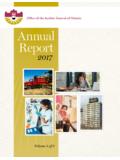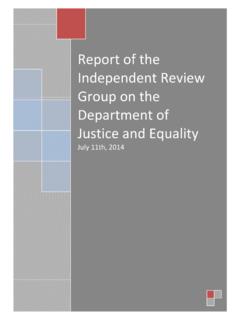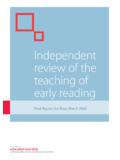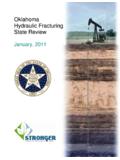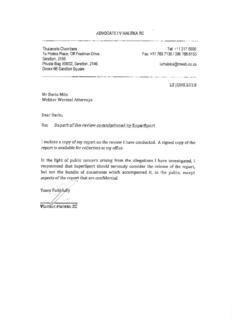Transcription of Review of the 2018 Pre-Election Report on …
1 Office of the Auditor General of OntarioApril 2018 Review of the 2018 Pre-Election Report on Ontario s FinancesOffice of the Auditor General of OntarioTo the Honourable Speaker of the Legislative AssemblyI am pleased to transmit my Review of the 2018 Pre-Election Report on Ontario s Finances for submission to the Assembly in accordance with the provisions of subsection 10(3) and section 13 of the Fiscal Transparency and Accountability Act, 2004, and Ontario Regulation 41/18. Bonnie Lysyk, MBA, FCPA, FCA, LPA Auditor GeneralApril 25, 2018 Toronto, OntarioISBN 978-1-4868-2073-3 (Print) ISBN 978-1-4868-2074-0 (PDF)Cover photograph credit.
2 Office of the Auditor General of Ontario/Mariana GreenAn electronic version of this Report is available at 2018, Queen s Printer for OntarioCe document est galement disponible en fran of Synopsis The independent Auditor General s Statement Background Objective and Scope Results 11 Appendix 26 Special Reportiv5 Review of the 2018 Pre-Election Report on Ontario s SynopsisThe government released its 2018 Pre-Election Report on Ontario s Finances ( Pre-Election Report ) on March 28, 2018, as required by the Fiscal Transparency and Accountability Act, 2004 (Act) and Ontario Regulation 41/18.
3 Under the Act, I am responsible for reviewing this Report to determine whether it is reasonable and for providing a statement describing the results of my Office s work. In this Report I fulfill this responsibility. The Act requires that the Pre-Election Report provide information about Ontario s finances for the fiscal year of the budget and the following two years. Accordingly, this year s Pre-Election Report presents information on Ontario s finances for the 2018/19, 2019/20 and 2020/21 fiscal years (as reported in the 2018 Ontario Budget).
4 Neither the Pre-Election Report nor my examination provides information for the 2017/18 fiscal year. Key financial items the government must Report on include economic forecasts and assumptions used to project revenues, expenses (including interest on debt), the reserves, the Province s surpluses or deficits and the ratios of provincial debt to Ontario s gross domestic product (GDP). We concluded that the Pre-Election Report is not a reasonable presentation of Ontario s finances insofar as its expense estimates are understated for two items (outlined in the bullets below), resulting in understated annual deficits.
5 After adjusting for these items, the annual deficit would be $ billion for 2018/19 (or 75% more than the reported $ billion), $ billion for 2019/20 (or 85% more than the reported $ billion) and $ billion for 2020/21 (or 92% more than the reported $ billion).When expenses are understated, the perception is created that government has more money available than it actually does. Government decision-makers might therefore budget more money to be spent on initiatives and programs, when that money is actually needed to pay for expenses the government has failed to record properly.
6 Therefore, more money will need to be borrowed to pay for the unrecorded expenses even when government reports an annual surplus or a balanced budget. A perception is also created of an improving trend in the relationship between the government s financial obligations and its capacity to raise funds to meet them, when the burden of net debt is actually increasing. The two understated expense items are: The government did not properly record the true financial impact of the Fair Hydro Plan s electricity rate reduction in the Pre-Election Specifically, the funds that ratepayers are not required to pay must be borrowed in order to pay power generators.
7 Neither the expenses to pay power gen-erators nor the interest on the funds borrowed to pay power generators have been included in the 1 Throughout this Report , our reference to the Fair Hydro Plan excludes the HST rebate and other taxpayer-funded estimates in the Pre-Election Report . As a result, the combined other program and interest expenses are understated by $ billion in 2018/19, $ billion in 2019/20 and $ billion in 2020/21. The government recorded pension revenue from the Ontario Teachers Pension Plan and insufficient pension expense from the Ontario Public Service Employees Union Pension Plan, both of which reduce the overall pension expense.
8 It should not have done this because it does not have the uni-lateral legal right to reduce its future contributions to these plans or to withdraw any surplus from these plans without first reaching a formal agreement with the plans other joint sponsors. Since there is no evidence that minimum contributions will be reduced or any surplus withdrawn, the gov-ernment continues to forecast making contributions to these plans of about $ billion in 2018/19, $ billion in 2019/20 and $ billion in 2020/21. The result of the incorrect recording of pension revenues and expenses is an understatement of other program expenses in the Pre-Election Report of $ billion in 2018/19, $ billion in 2019/20 and $ billion in 2020 stated principle in the Act is that the government s fiscal policy should be based on cautious assump-tions.
9 Aside from the above two significant items, we found that the government based its estimates of revenues, program expenses and interest on debt on cautious assumptions, as required by the Act. The gov-ernment also showed prudence by including a reserve amount in its fiscal plan (although it is lower than in previous years), again as required by the Act. We further concluded that the assumptions used to prepare the Pre-Election Report are consistent with the plans of the government of Ontario (as reflected in the 2018 Ontario Budget).
10 The Pre-Election Report has been prepared on a basis that is consistent with the Act and generally consistent with the guidance for future-oriented financial information from the Chartered Profes-sional Accountants of Canada. However, the Pre-Election Report does not contain a prescribed general-purpose future-oriented income statement (a Consolidated Statement of Estimated Revenues, Expenses and Reserve), as required by the guidance for future-oriented financial information issued by the Chartered Professional Accountants of Canada.


